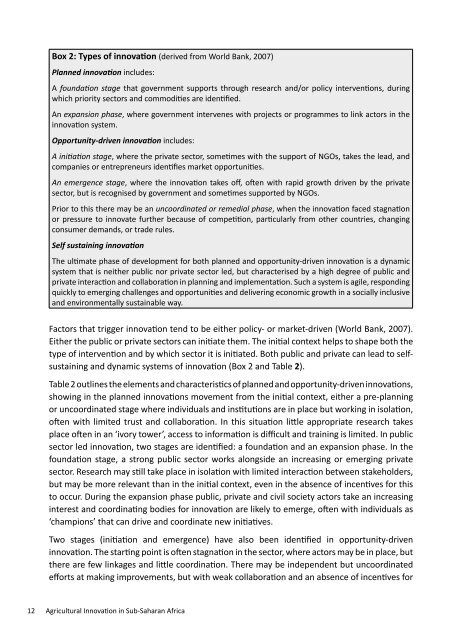1C1KKTs
1C1KKTs
1C1KKTs
Create successful ePaper yourself
Turn your PDF publications into a flip-book with our unique Google optimized e-Paper software.
Box 2: Types of innovation (derived from World Bank, 2007)<br />
Planned innovation includes:<br />
A foundation stage that government supports through research and/or policy interventions, during<br />
which priority sectors and commodities are identified.<br />
An expansion phase, where government intervenes with projects or programmes to link actors in the<br />
innovation system.<br />
Opportunity-driven innovation includes:<br />
A initiation stage, where the private sector, sometimes with the support of NGOs, takes the lead, and<br />
companies or entrepreneurs identifies market opportunities.<br />
An emergence stage, where the innovation takes off, often with rapid growth driven by the private<br />
sector, but is recognised by government and sometimes supported by NGOs.<br />
Prior to this there may be an uncoordinated or remedial phase, when the innovation faced stagnation<br />
or pressure to innovate further because of competition, particularly from other countries, changing<br />
consumer demands, or trade rules.<br />
Self sustaining innovation<br />
The ultimate phase of development for both planned and opportunity-driven innovation is a dynamic<br />
system that is neither public nor private sector led, but characterised by a high degree of public and<br />
private interaction and collaboration in planning and implementation. Such a system is agile, responding<br />
quickly to emerging challenges and opportunities and delivering economic growth in a socially inclusive<br />
and environmentally sustainable way.<br />
Factors that trigger innovation tend to be either policy- or market-driven (World Bank, 2007).<br />
Either the public or private sectors can initiate them. The initial context helps to shape both the<br />
type of intervention and by which sector it is initiated. Both public and private can lead to selfsustaining<br />
and dynamic systems of innovation (Box 2 and Table 2).<br />
Table 2 outlines the elements and characteristics of planned and opportunity-driven innovations,<br />
showing in the planned innovations movement from the initial context, either a pre-planning<br />
or uncoordinated stage where individuals and institutions are in place but working in isolation,<br />
often with limited trust and collaboration. In this situation little appropriate research takes<br />
place often in an ‘ivory tower’, access to information is difficult and training is limited. In public<br />
sector led innovation, two stages are identified: a foundation and an expansion phase. In the<br />
foundation stage, a strong public sector works alongside an increasing or emerging private<br />
sector. Research may still take place in isolation with limited interaction between stakeholders,<br />
but may be more relevant than in the initial context, even in the absence of incentives for this<br />
to occur. During the expansion phase public, private and civil society actors take an increasing<br />
interest and coordinating bodies for innovation are likely to emerge, often with individuals as<br />
‘champions’ that can drive and coordinate new initiatives.<br />
Two stages (initiation and emergence) have also been identified in opportunity-driven<br />
innovation. The starting point is often stagnation in the sector, where actors may be in place, but<br />
there are few linkages and little coordination. There may be independent but uncoordinated<br />
efforts at making improvements, but with weak collaboration and an absence of incentives for<br />
12 Agricultural Innovation in Sub-Saharan Africa


